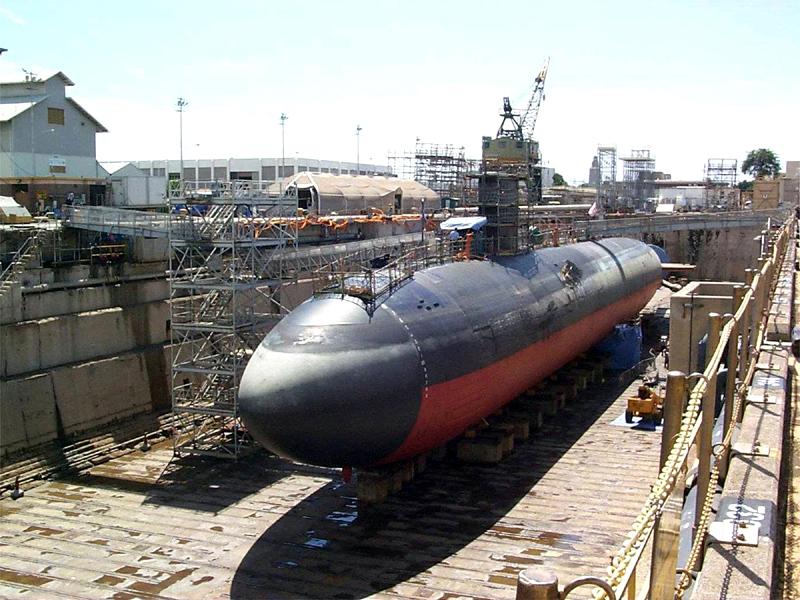
The attack submarine USS Greenville in drydock.
WASHINGTON: A grim 75 percent of the Navy’s carrier and submarine fleets are unable to make it through scheduled repairs on time, averaging 113 days late for aircraft carriers and 225 days late for submarines.
The findings by the Government Accountability Office shed new light on a problem the Navy has not been able to get its hands around, and led the service to implement an emergency call up of 1,629 Reservists in June to pitch in on repair work at the service’s four shipyards.
The new report, which charted shipyard issues between 2015 and 2019, noted that despite the Navy boosting its shipyard workforce by 3,800 people and spending $2.8 billion to address shipyard performance during that time period, ships continue to languish in port.
In responses to the GAO, the Navy said things for the attack submarine fleet in particular are likely to get worse before they get better. Idle time, or the time a Los Angeles or Virginia-class submarine waited before work could begin, increased each year from 100 days in 2015 to an astounding 1,019 days in 2019, representing a 919 percent increase.
“According to Navy officials, they expect the number of days of idle time to continue to increase for the next 2 fiscal years,” the report states, noting that as of June of this year, according to NAVSEA officials, of the four submarines planned to wrap up their repair work in 2020, three would be delayed, while wrapped up five days early.
Even while so many attack subs sit idle in port awaiting repair, theater commanders continue to call for the undersea asset at levels as high as ever as the Chinese navy continues to increase its size and rate of deployments, and Russian subs prowl the North Atlantic with increasing regularity.
The backlogs will be increasingly difficult to push through, as Pentagon budgets are likely to remain flat in coming years, pinching shipbuilding and repair budgets as the Navy moves out on its new Columbia-class submarine effort at the same time it undertakes a major overhaul of many Virginia-class subs.
An analysis of the 2021 defense budget and future defense trends published today by Todd Harrison and Seamus Daniels of CSIS paints a grim picture of future miltiary spending. The skyrocketing national debt and the economic impact of the COVID-19 pandemic will force some tough choices on the federal government in the coming years, they say. “Fiscal austerity will inevitably force DoD to consider difficult strategic choices that it has largely avoided until now. DoD can preserve strategic maneuver space by beginning to prepare for a drawdown now. But the longer these preparations are delayed, the narrower the range options available will become.”
But work will continue. Large-scale work on the first of the 12 planned Columbia submarines is slated to kick off in 2021, with deliveries starting in 2030 — just in time to begin replacing the Cold War-era Ohio-class subs as the Navy’s leg of the nation’s nuclear triad. The subs will carry 70 percent of the warheads allowed by the New Start treaty with Russia.
Last year, the Navy awarded a $22.2 billion deal to Electric Boat and Huntington Ingalls for nine new Virginia-class submarines, which the service says will make them more lethal, and much harder to detect when operating close to hostile shores. The contract includes an option for a tenth boat, which would bring the contract up to $24.1 billion if enacted. The program would see the delivery of the first fast-attack sub in 2025.
Global military spending hits ‘all-time high’ of $2.4 trillion: SIPRI report
The US remains the world’s largest defense spender, outlaying $916 billion last year, a 2.3 percent annual increase, ahead of China in second place, which spent an estimated $296 billion, a 6 percent increase over the same period.



























